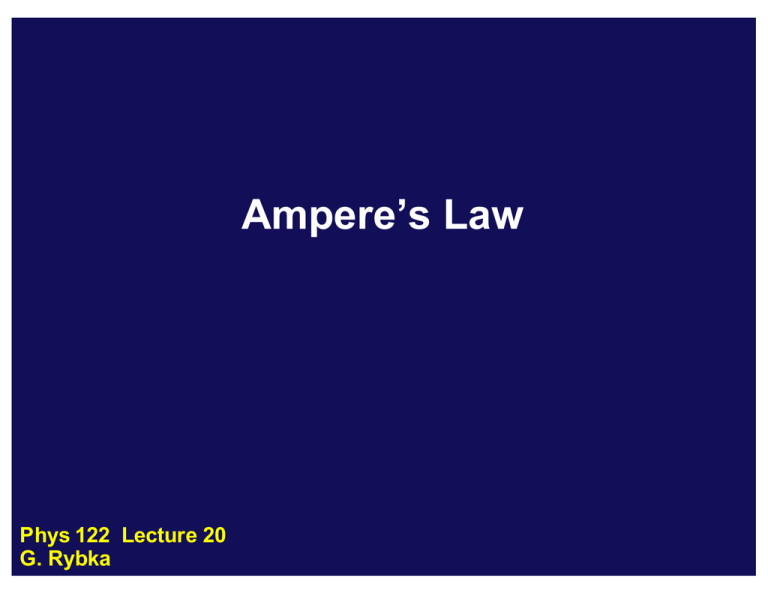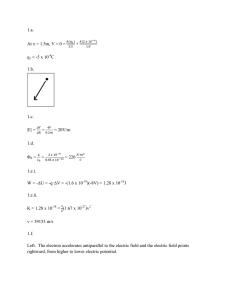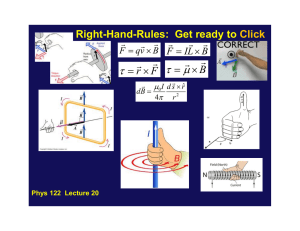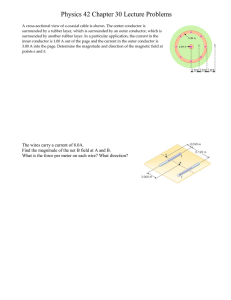Lecture Notes
advertisement

Ampere’s Law Phys 122 Lecture 20 G. Rybka Some good questions from the Prelecture Electric fields do not exist inside conductors. Do magnetic fields exist? Could we spend more time talking about the properties of magnetic fields inside and outside hollow tubes? How does that differ from magnetic fields inside and outside solid cylinders? So, I can't go to your office hours because I have class right after Physics on Friday, what is the best source of getting down the right hand rule down in all of the different cases? This is still holding me back, even though this Ampere's Law was still pretty easy for me. We learned that charges are distributed on the surface of a conductor, and the current is the result of flowing charges. If the charges are all distributed on the surface of a wire, does that mean the current only flows on the surface of the wire? Right-­Hand-­Rules: Get ready to Click ! ! ! ! ! ! F = qv × B F = IL × B ! ! τ = µ! × B! τ = r ×F ! µ0 I d s! × rˆ dB = 4π r 2 Clicker rail L1 L2 C S B V L3 A) B) C) D) E) R A conducting rail of length L1 rests on the top of the circuit loop as shown. It is free to move. A uniform magnetic field exists in the box of dimension L2 by L3. When switch s is closed, which way does the rail move (if at all) ? Left Right Rotates clockwise Rotates counterclockwise Does not move • Current through rail is down • B is pointed toward you • IL x B is to the LEFT Clicker rail L1 L2 C S B V L3 A) B) C) D) E) R A conducting rail of length L1 rests on the top of the circuit loop as shown. It is free to move. A uniform magnetic field exists in the box of dimension L2 by L3. What is the magnitude of the force on the rail RC seconds after the switch has been closed? 0.37(V/R) 0.63(VL2B)/R 0.37(VL1B)/R 0.37(VL2B)/R Help, or My answer wasn’t listed L • • • • Force on segment is F = IL2B (it’s at right angle) I(t) = (V/R) exp(-­t/RC) I(RC) = 0.37V/R F = 0.37(VL2B)/R Clicker • A loop of wire is formed in this circuit as shown on the right of the drawing. • We label the direction of positive current through the loop, +I, as shown I 2V0 • What is the direction of the current and the magnetic moment? A) B) C) D) I is > 0 I is < 0 I is > 0 I is < 0 R & µ is out of the page & µ is out of the page & µ is into the page & µ is into the page 1. -­2V + 5V + IR = 0 2. I = -­ 3V/R;; à clockwise through that loop 3. RHR follow clockwise current à µ into page 5V0 Clicker z • Consider the loop of current shown, which is located in a uniform vertical magnetic field. • About which axis might this loop rotate? A) B) C) D) x y z It will not rotate 1. Magnetic moment µ is into page (+y) 2. Torque on loop is µ x B (+x direction) 3. Loop rotates around direction of torque • à i.e., around the x axis y x B The Rest of Today is Ampere’s Law Day "High symmetry" ∫ B • dl = µ I 0 Integral around a path … hopefully a simple one Current “enclosed” by that path ´ I Infinite current-­‐carrying wire " " LHS: ∫ B • d ! = ∫ Bd! = B∫ d! = B ⋅ 2πR RHS: I enclosed = I µo I B= 2πR General Case Checkpoint Summary: Not bad CheckPoint 2 Ienclosed = I Ienclosed = I CheckPoint 4 CheckPoint 6 CheckPoint 8 Cylindrical Symmetry X X X X Enclosed Current = 0 Check cancellations Can we assume uniform current? Yes In electrostatics, only the superfluous charges get to the surface. The negative electrons that cancel the positive nuclei are still inside the metal. They form negative charge density, which is cancelled by the positive charge density of the nuclei. In statics, these densities are uniform. These distributed electrons later form the DC current. The electrons do repel each other, but this is balanced by the positive nuclei, so the electrons are not pushed out to the surface, but can stay distributed in the volume. From Prelecture: B Field of a Long Wire • Inside the wire: (r < a) µ0 I r B= 2π a2 * • Outside the wire: (r>a) µ0 I B= 2 πr * Just calculate the current enclosed vs. r. Similar to charge enclosed problems with Gauss Law for uniformly charged shapes. Clicker Two cylindrical conductors each carry current I into the screen as shown. The conductor on the left is solid and has radius R = 3a. The conductor on the right has a hole in the middle and carries current only between R = a and R = 3a. 3a I – What is the relation between the magnetic fields at R = 6a for the two cases (L=left, R=right)? I a 3a 2a (a) BL(6a)< BR(6a) (b) BL(6a)= BR(6a) (c) BL(6a)> BR(6a) • Ampere’s Law with a circular loop at radius R = 6a • The field in each case has cylindrical symmetry, being everywhere tangent to the circle. • So, field at R = 6a depends only on the total current enclosed • In each case, a total current I is enclosed. Clicker Two cylindrical conductors each carry current I into the screen as shown. The conductor on the left is solid and has radius R = 3a. The conductor on the right has a hole in the middle and carries current only 3a between R = a and R = 3a. I I a 2a 3a 2a What is the relation between the magnetic field at R = 2a for the two cases (L=left, R=right)? (do the calculation) (a) BL(2a)< BR(2a) (b) BL(2a)= BR(2a) (c) BL(2a)> BR(2a) • Field depends only on how much current is enclosed. Figure it out. • For the LEFT conductor: • For the RIGHT conductor: π ( 2a ) 2 4 IL = I= I 2 9 π (3a) ( ( ) ) π ( 2a ) 2 − a 2 3 IR = I= I 2 2 8 π (3a) − a ( 0.444 I > 0.375 I ) B Field of ¥ Current Sheet • Consider an ¥ sheet of current described by n wires/length each carrying current i into the screen as shown. • Direction of the B field? • Symmetry Þ y direction! • Apply Ampere's law with square of side w: • ! ! ∫ B• d l = Bw + 0 + Bw + 0 = 2 Bw • I = nwi ∴ ! ! ∫ B• d l = µ 0 I Þ constant µ 0 ni B= 2 y x x x x x x x x x x x x x w constant B Field of a Solenoid • Purpose: makes a constant magnetic field • A solenoid is defined by • a current I flowing through a wire which is wrapped n turns per unit length on a cylinder of radius a and length L. L a • If a << L, the B field is to first order contained within the solenoid, in the axial direction, and of constant magnitude. • In this limit, we can calculate the field using Ampere's Law. CMS magnet at the LHC B Field of a ¥ Solenoid • First, justify claim that the B field is 0 outside the solenoid. • View solenoid from the side as 2 ¥ current sheets. • Same direction of fields between sheets x x x x x x x x x x x • • • • • • • • • • • • • • • They cancel outside the sheets • Draw square path of side w: ! ! ∫ B• d l = Bw I = nwi x x x x x x x x • • • • • • • • • • • Þ B = µ 0 ni CheckPoint 10 Use the right hand rule and curl your fingers along the direction of the current. Another important “real” magnet: Toroid• • • Toroid defined by N total turns with current i. • • B = 0 outside toroid! • • Consider integrating B on circle outside toroid;; net I enclosed = 0 • • I = Ni ! ! Apply Ampere’s Law: ∫ B• d l = µ 0 I Þ µ 0 Ni B= 2 πr • • • xxx x x x x xx • For B inside, consider circle of radius r, centered at the center of the toroid. ! ! ∫ B• d l = B(2 πr) • x • x x r xx xx • B• • • •




